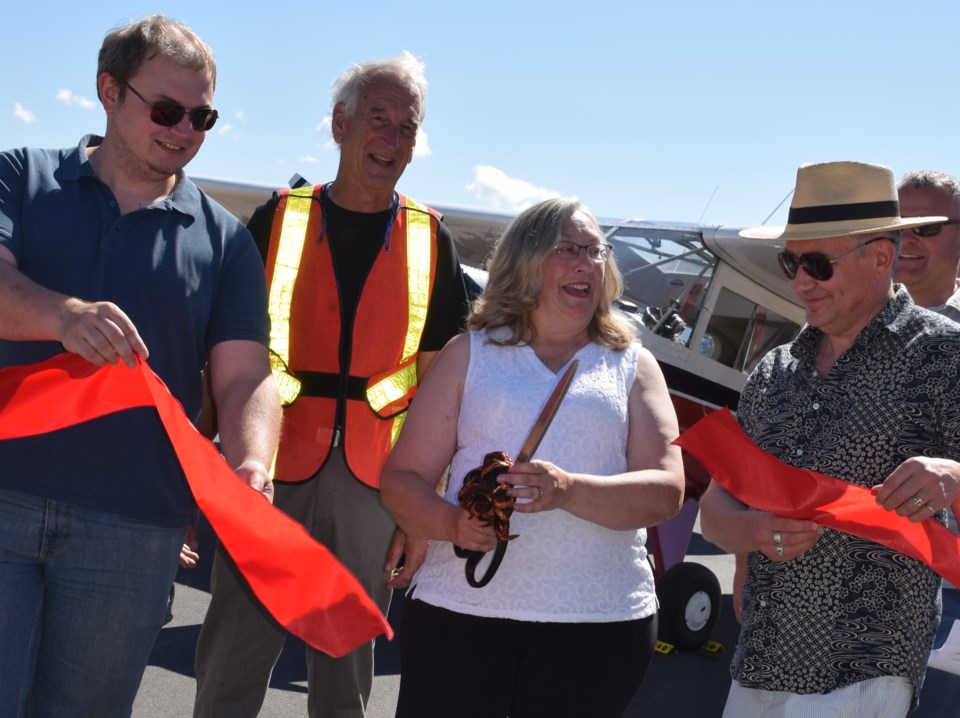With the first aircraft to land at Sechelt’s aerodrome in 1957 behind her, Mayor Darnelda Siegers cut a ribbon to officially open the $3.7-million runway extension and improvement project on July 24.
“This runway expansion was fully funded by grants and will ensure the safety of our aerodrome for years to come, while providing opportunities for economic development,” Siegers told the crowd of about 150 people.
“These improvements have been in the planning stages for nearly a decade and I am pleased we have been able to make this vision a reality, at no cost to the Sechelt taxpayer.”
Siegers thanked MLA Nicholas Simons, who attended the opening, for the province’s support for the work.
Sechelt received two BC Air Access Program grants totalling $2.38 million to help pay for the 284 metres of new runway, repaving of existing runway and apron spaces as well as a precision approach path indicator lights system to replace the runway lights.
It also used money from provincial gas tax and COVID restart programs.
Speaking at the event, Simons said he had experienced two aborted small aircraft landings in his life, and that one was on the unimproved runway at Sechelt.
“Hopefully, that is a thing of the past,” he said.
The extended runway was back in service on June 22 and the lighting changes are to be completed within the coming weeks.
The runway reopening event was billed as a community celebration. Aircraft displays, children’s activities, refreshments, a DJ and display of the local volunteer fire department’s new ladder truck were part of the mix.
There were about 16 aircraft on display, including a Fleet 80 Canuck which served as the backdrop for the ribbon cutting and made the inaugural landing on the runway in 1957.
It was flown into the event by current owner Bruce Dignem, who told Coast Reporter that Roy Brett, a logger and aviation enthusiast, completed the first landing and owned the aircraft for many years. Brett was also involved in clearing the original land for the airstrip.
While the audience was generally upbeat at the celebration, some were concerned about how the improvements will impact the future of drag racing at the airport. Some attendees, in support of allowing the Sunshine Coast Drag Racing Association’s (SCDRA) continued use of the facility, made their views known.
Bumper stickers reading “I support the SCDRA” were displayed to the elected officials speaking during the event’s official program. On July 9, council put a hold on the SCDRA’s 21-year racing tradition at the facility until after June 22, 2022, while the newly paved runway is under warranty.
Mike Smith, an SCDRA member who has volunteered as a track-side operations manager during past racing events, spoke with MLA Simons at the event about options for the racers moving forward. Smith said Simons was supportive, “as much as any politician can be.”
When it comes to the future of drag racing at the aerodrome, Smith said it is up to the community of Sechelt to decide “which way they are going to put their votes”.
Asked about alternatives to use of the upgraded runway for racing, Smith said he had heard about the idea of developing a race strip parallel to the runway’s north side, but was not sure where that money would come from.
“I don’t understand why we can’t all use the existing facility,” he said. “There’s no reason to have two runways. We all pay for the maintenance of it.”
If council removes drag racing from the facility, he said, “they will remove a lot of sales from local hotels, restaurants and businesses.”
He added that if access to the aerodrome, which provides a safe space for racing, is denied, council needs to provide an alternative and a budget to develop any new site.
Sechelt councillors Eric Scott and Alton Toth were part of the ribbon cutting.
Scott, chair of the municipality’s airport development select committee, told Coast Reporter that the safety of the facility has been vastly improved with the upgrades. He said the improvements mean that a wider spectrum of aircraft will be able to use the facility.
No commitments have been made by new firms looking to operate out of the aerodrome, but “there is a lot of interest,” Scott said.
Sechelt’s next steps in moving the aerodrome towards airport status, he said, are updating management and strategic plans for the facility. “These have to come. We need to ensure the asset is taken care of and there is revenue generation from this. Right now, it does pay for itself. It would be nice to have more revenue so we can pay for more stuff.”
The aerodrome has a part-time onsite manager, supported by District of Sechelt staff members, who handle aerodrome duties along with their other responsibilities. The select committee provides recommendations to council, the decision-making authority for the asset.
Sechelt’s most recent business case for a full airport is dated November 2012. Scott said that document contains errors and needs to be updated with something that is more realistic.
Sechelt’s use of gas tax money for runway improvements had been a concern for Toth. At the event, he told Coast Reporter, while he initially was not in favour of diverting those funds away from the municipality’s road repair budget, he was very pleased to see another key transportation asset improved.
He said the extended and improved runway will serve the entire Coast and could be instrumental infrastructure should an emergency, such as an interface forest fire, occur.



